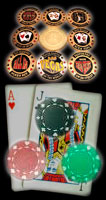FLUSH DRAWS
There are four categories of flush cards and they all play a little differently.
There are suited Aces, suited big-little (such as K ![]() 5
5 ![]() or Q
or Q ![]() 5
5 ![]() ), suited connectors, and other suited cards.
), suited connectors, and other suited cards.
The strongest of these are the suited Aces and the suited connectors.
The suited Aces are, of course, draws to the best possible flush.
That’s not really their primary strength, because suited Aces and suited connectors tend to have other drawing features when they flop flush draws.
The Ace is an overcard, adding three outs to the hand, and suited connectors often flop a straight draw, or a gutshot straight draw to combine with the flush draw.
These extra three or four outs are what make them premium draws.
A flush draw is about a 4-1 underdog to make in one card. It’s about a 2-1 underdog to make in two cards. When you have a flush draw, you know that you will need 4-1 pot odds to call a bet on the turn.
If the game is only a little loose, you also know the pot will be big enough to give you those odds.
That means that when you evaluate a flush draws on the flop, you can think about the odds of making it in two cards but don’t have to worry about the cost of those two cards.
The pot will pay for the second card. The current betting round is what pays for the first card.
If the pot is large enough on the turn to give you 4-1pot odds, then you only need two callers on the flop to give you sufficient odds to bet or raise an Ace-high flush draw for value.
This makes flush draws very strong and the flop in a loose or very loose game because you don’t need pot odds to call on the flop.
It’s even stronger in a very loose, very aggressive poker game because you only need 3-1 bet odds to profit significantly from a bet or raise.
If you’re in that situation where you have three or four callers, and one of them raises for you, then that’s just free money.
If you don’t see any solid tells that would indicate that you’re drawing to a second-best flush, then you will want to play a flush draw at a loose table very aggressively.
You want as many callers as you can get, but you also want to put as many bets in the pot as you can.
As we mentioned before, a flush draw is a 2-1 underdog on the flop if you’ll take the hand to the river. You’ll make the flush once for every two times you miss.
That means, if you’re getting 3-1 on your bets on the flop, you’ll make money if you know your flush will be good. Because we’re never quite sure about that, you want to get 4-1.
If you get four callers on the flop whenever you bet a flush draw, you will make a lot of money on flushes.
Son, on the flop you want to bet or check-raise in such a way as to trap players, not to thin the field. If you think a player to your left will bet, then you should check-raise.
If you think a player on the button will raise, then you should bet from UTG, and reraise him if three players besides him have called.
You aren’t semi-bluffing; you aren’t trying to think the field; you’re trying to get as much money, from as many players, as you can.
If your table is very loose and at least somewhat aggressive, you can exploit that by playing a lot of flush cards. The reason for this is that you’ll be paid off.
Getting paid off with a flush involves more than just getting called when you make the flush.
If also involves getting extra bets in the pot when you’ve got a draw. In a loose, somewhat aggressive game, this can be a major source of winning money.
Pick the Right Table / Picking a Seat / Theories of Poker / Betting Theory: The Odds
A Theory of Starting Hand Value
A Theory of Flop Play: Counting Outs and Evaluating Draws
The Dynamics of Game Conditions / Table Image / Player Stereotypes
Women and Poker / Spread-Limit Games / Double Bet on the End Games / Kill Games
Short-handed Games / Tournaments / No-limit and Pot-Limit Poker



